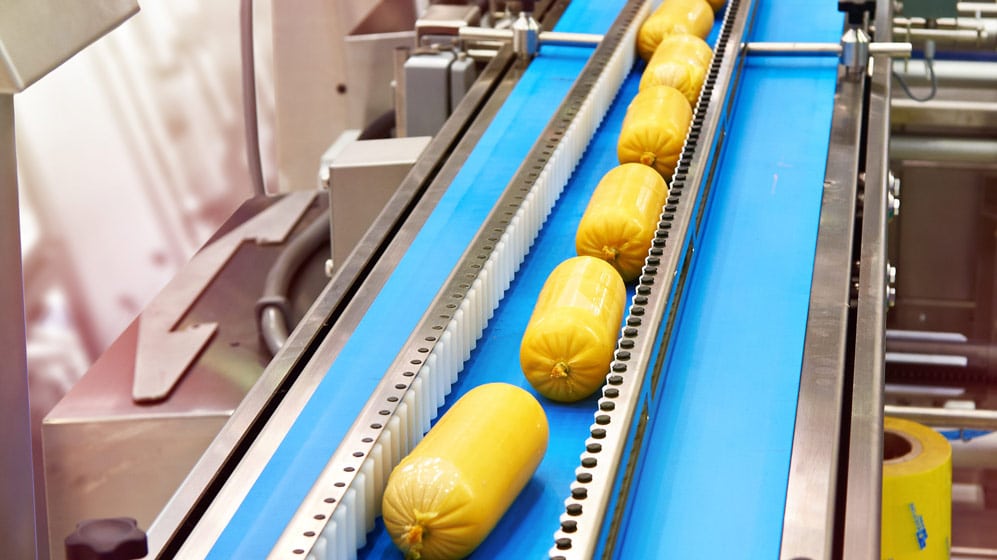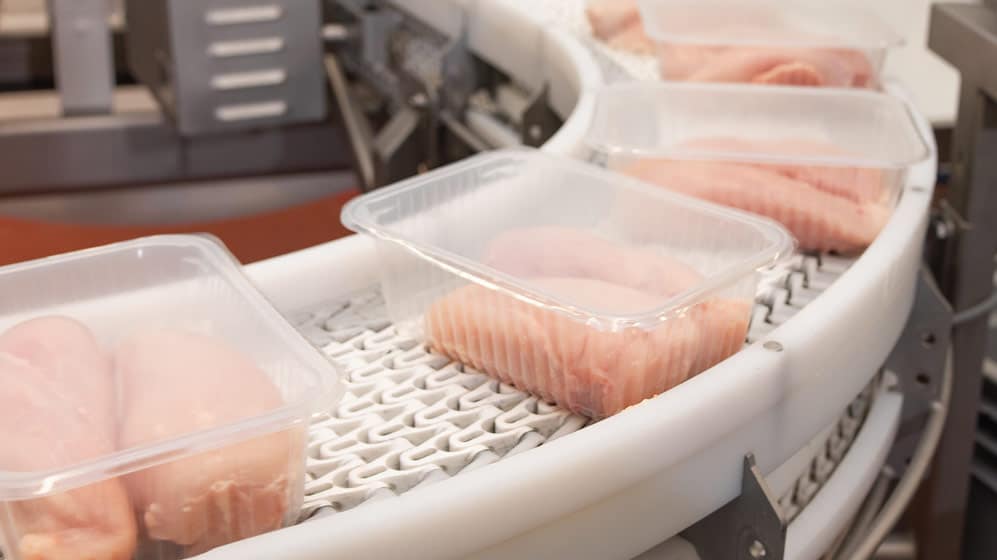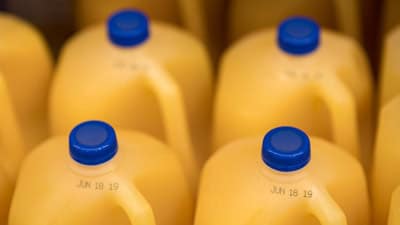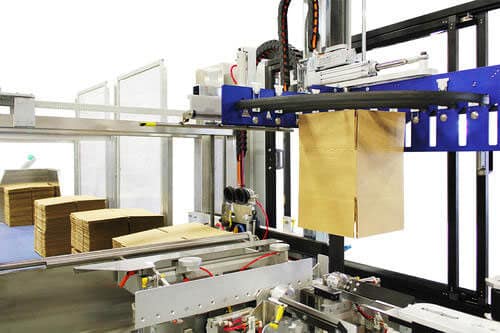Whether you’re a small- or mid-sized manufacturer in the food and beverage industry, automation is key for your business to thrive and grow. Manufacturing automation systems use technology to mechanize certain processes, including production, assembly and packaging.
If your lines allow for it, automation enables 24/7/365 without downtime or breaks. It also helps you make better use of your human workers by handling repetitive, hard-to-fill positions that involve:
- Packaging and labeling
- Loading and unloading materials
- Sorting and testing products
- Operating machinery and equipment
- Performing quality checks on products
- Maintaining production logs
Automation also helps reduce waste and damage to products, while improving throughput and fulfillment speeds due to its accuracy and speed of execution. It can also help increase output quality and consistency of goods by eliminating human error from the equation.
While automating your manufacturing process is an investment, it will pay off over time. Let’s review the different types of automation and equipment available, as well as grants and loans that can help offset your investment.
Warehouse Automation Explained
There are two different kinds of warehouse automation.
Process Automation
By using process automation, warehouses are able to collect and analyze data quickly and efficiently. Process automation includes the hardware and software used to create a snapshot of a warehouse’s status. Bar codes, scanners and automated computer programs can help streamline the inventory process.
Hard Automation
Hard automation involves using industrial robots in a warehouse setting. This type of automation reduces manual labor for high-volume needs and helps streamline operations, resulting in increased efficiency and productivity. Robotics can be used for tasks such as sorting items quickly, picking items from shelving units, packing goods into containers, moving objects from one location to another or even placing items on conveyor lines.
Warehouse Automation Equipment for Food and Beverage Manufacturers
Conveyor Systems

Conveyor systems move materials from one place to another, such as from a storage area to the production line. They can be used to sort and transfer items, as well as controlling the production process flow by synchronizing with other machines or processes on the production line.
Food grade conveyors are designed to transport food products safely and efficiently, preventing contamination or spoilage. They are typically made of stainless steel or other corrosion-resistant material, with features such as removable modular belts for accessible cleaning and maintenance. In addition, food grade conveyors may have sensors and automation capabilities to monitor speed, temperature and pressure.

Automatic Liquid Filling Machines
Automatic liquid filling machines fill drink, sauce and condiment containers. These machines are designed to be accurate and consistent in their outputs, ensuring a precise quantity of product is filled into each container without over- or under-filling.
Product Identification Systems
Product identification systems track, trace and identify products throughout the supply chain. They often incorporate barcodes, RFID tags or other types of digital identifiers into labels, packaging and product surfaces.
These digital identifiers can be used to monitor and track products in real-time as they move from the production line to store shelves. Product identification systems also enable food manufacturers to quickly access information about their products, such as ingredients, nutritional facts and expiration dates.
Warehouse Labeling Systems
Food and beverage manufacturers use warehouse labeling systems to easily identify, organize and manage stored goods in their warehouses. Labels with barcodes or other identifiers are used to denote product type, expiration date, lot number and other information that can help the manufacturer track products in the inventory system.
Skin Packaging Equipment and Thermoform Packaging Machines
Food manufacturers use skin packaging equipment to create a sealed package that is formed around the product using a flexible film material. The packaging machine seals the product and film together, providing a secure fit without any additional adhesives. This type of packaging is often used for fresh and frozen foods, as it provides an airtight seal that helps keep the food safe from contamination.
Thermoform packaging machines are typically used by food manufacturers when packaging products with complex shapes or those that need to be sealed with a vacuum. The machine forms a plastic sheet around the product to create an airtight package and can also be used to add additional features such as peel-away seals or lids. Thermoform packages help maintain product freshness and shelf life by protecting against moisture, oxygen and other elements.
Automatic Shrink Wrappers
Food manufacturers use automatic shrink wrappers to package products for retail sale. The machine wraps a heat-shrinkable film around the product and then uses hot air to shrink the film, creating a tight seal that prevents the item from moving or becoming damaged during shipping and storage.
This type of packaging also helps food stay fresh by reducing moisture, oxygen and other elements that can damage or spoil the product. Automatic shrink wrappers also come with features such as tamper-evident seals and barcode printing, making it easy to track products in inventory systems.
Automatic Case Forming, Sealing and Packing
Automatic case formers and sealers create and seal cardboard boxes for shipping food and beverage items. The machine creates the box from a corrugated sheet. An automatic case packer can then fill the carton with products before the sealer covers the top and bottom flaps of the box with adhesive or tape. If you need to fill cartons quickly, a high-speed pick and place robot is a smart solution.
Palletizing Robots and Robotic Depalletizer Systems
Palletizing robots and robotic depalletizer systems streamline loading and unloading of products onto and off of pallets. Palletizing robots are able to quickly pick up boxes or bags of product, load them onto a pallet and then stack them in an organized way to ensure the items remain stable during transit.
Robotic depalletizers are used to lift product off of a pallet automatically, speeding up the unloading process and eliminating the need for manual labor.
Automated Storage and Retrieval Systems
Automated storage and retrieval systems (AS/RS) are used to quickly store, retrieve and deliver product with minimal manual labor involved. AS/RS systems are equipped with robotic arms that pull items from shelves or bins, allowing for fast and accurate movement of inventory throughout the warehouse. They also reduce floor space requirements, as the shelving is not arranged in aisles like in traditional warehouses.
Loans and Grants to Offset Automation Costs
Nationwide Loan Programs for Manufacturers
The U.S. Small Business Administration offers lending and investment products to help small manufacturers obtain more than $5 billion in capital to get started and grow:
- The CDC/504 Loan Program provides long-term, fixed-rate financing of up to $5 million to help manufacturers automate, upgrade or acquire major fixed assets such as equipment and facilities that promote business growth and job creation.
- 7(a) loansprovide manufacturers with vital working capital to purchase equipment, make and implement process improvement plans, acquire inventory and hire employees.
Grants for Iowa Manufacturers
The Iowa Manufacturing 4.0 Technology Investment Program provides grants for small- and mid-sized manufacturers to offset the costs of industrial robots. Qualifying manufacturers can apply for up to $50,000 through Manufacturing Innovation Equipment Grants.
To qualify, manufacturers must:
- Be incorporated or authorized to do business in Iowa
- Employ a minimum of three and fewer than 75 full-time employees across all locations
- Designate with NAICS codes falling between 31-33 (used in the Manufacturing 4.0 report)
- Derive a minimum of 51% of their revenue from the sale of manufactured goods
- Have been operating for at least three years
While Iowa State University’s Center for Industrial Research and Science (CIRAS) doesn’t offer grants, they’re a great asset for connecting small- and medium-sized Iowa manufacturers with resources via the Manufacturing Extension Partnership to help them thrive and grow.
Grants for Illinois Manufacturers
The Illinois Manufacturing Innovation Voucher awards up to $25,000 in matching funding for manufacturers to accelerate technology adaption like robotics. Voucher projects must be conducted in Illinois for existing manufacturers with up to 500 employees.
Grants for Minnesota Manufacturers
The Minnesota Department of Employment and Economic Development offers an Automation Training Incentive Program, which helps small businesses train existing workers on new automation technology.
Grants of up to $35,000 are available to small businesses in the manufacturing or skilled production industry.
To qualify, manufacturers must:
- Be located outside the seven-county metropolitan area, or in Cannon Falls, Hanover, Rockford, Northfield or New Prague.
- Be providing training for existing full-time jobs that pay at least 120% of the federal poverty guidelines.
Partner with RMH Systems for Your Next Warehouse Automation Project
Automation is here to stay and responds quickly to unpredictable events while also providing a more predictable production process. When combined with the knowledge and quick decision-making of humans, automation can become an integral part of your operations, helping you improve production capabilities and implement growth-orientated strategies.
If you’re exploring automation solutions for your operations, get in touch with our experts to find out how we can help. RMH handles your automation project fully in-house, from engineering to design, turnkey installation and aftermarket service. This helps you save time you’d otherwise spend coordinating with multiple vendors.
Together we’ll discuss the possibilities for your business and develop a plan that works best for you.

